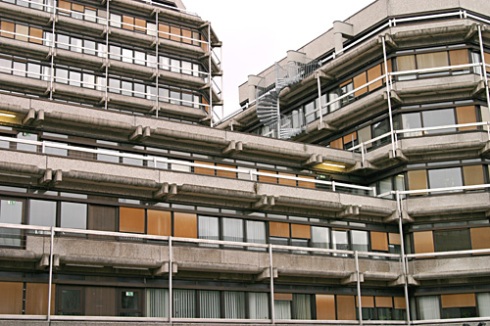The Old Town of Frankfurt/Main was destroyed by air strikes in the World War II. Today this part of the city is shaped by buildings and streets of houses which have been built in the era of reconstruction. One of the new buildings, without a historical forerunner is the ‚Technisches Rathaus‚, a town-hall. Another new buildings are the Schirn-Art-Center and the frame-work houses on the eastern side of the Römerberg. In contrast to this buildings, some other destroyed buildings were reconstructed, eg. the city hall Römer or the six patrician houses on the eastern side of the Römerberg. The Wikipedia-article ‚Frankfurt-Altstadt‚ is quite instructive.
I like this town-hall building, the ‚Technisches Rathaus‚, its octagonal high-rises. But I assume, that most people disrelish it and call it gross or ugly. Admittedly, this building is really unloading, and it appears unaccessible. I have heard that this building stands for a so-called ‚Betonbrutalismus‚ (‚concrete brutalism‘). But the choice of building materials (exposed-aggregate-concrete, concrete, glass, steel) and the massive form identify the bulding as a typical product of its time (see the Architectural Guide Frankfurt/Main, by W.-C. Setzepfandt, Dietrich Reimer Verlag 2002, p. 55). The building seems to be typical for the architecture of the sixties, but it is widespread to abominate this era of architecture. Headwords as ‚Verdichtung‚ (aggregation), ‚kompakte Großstrukturen‚ or ‚Betonbrutalismus‚ rouse negative associations (see for example an article by Tanja Seeböck in kunsttexte.de). The finnish professor and architect Aarno Ruusuvuori (1925-1992) apprehended the notion ‚Betonbrutalismus‘ as a compliment. He avowed uncomprisingly this modern building material. He believed that concrete is not only fine, but also ecological (see www.schneeland.com). Setzepfandt informs us, that the roofs of the ‚Technisches Rathaus‘ were designed to math the roofs of surounding buildings in Frankfurt’s historical center. According to him the facade is both „difficult“ and elaborate corresponding with the surroundings.
Occasionally, when I was younger, a 10 to 12 years old boy, we made trips to Frankfurt. At that time for me this town-hall building made a strong visual impact, it seems to be so unloading, massive and bulky – by all means different to similar buildings in my hometown. Together with the multistoried buildings, which seemed to me at that time so tall (although the today’s still higher skyscrapers not existed at that time), this town-hall building symbolized Frankfurt, the big city. Particularly I loved this big, quaint souvenir shop in the ground floor, full of knickknack and trash. This shop is still there. Recently, I have betoken the building as a ‚concrete blastula‘, in order to refer to the unloading structure. But better suited seems to be the comparison with a dead coral reef. This natural metaphor is from Alfred Döblin’s novel ‚Berlin Alexanderplatz‚ (1929) (I have got it from Karl Schlögl’s „Im Raume lesen wir die Zeit„, Carl Hanser Verlag, München & Wien 2003, p. 304) .
The ‚Technisches Rathaus‚ will be demolished, and there is a lively discussion over the future arrangement of the Old Town between the Frankfurt Dom and the Römer city-hall. At the moment there is the tendency to reconstruct older buildings and streets of houses (see for example the dossier in the Frankfurter Rundschau or the dossier in the Frankfurter Allgemeine Zeitung; and this link is interesting too.
Furthermore I am afraid, that the intention to reconstruct old buildings can grow into a medieval-style reconstruction mania. Meanwhile, they want to pull down the concrete parts of the Museum of History. Consequently continued, one day in the future the Schirn-Art Center could appear on the demolition list too.







See the Post „Scar Tissue“ from Nathanael D. Care im George Mason’s University’s History News Network: http://hnn.us/blogs/entries/41841.html
Unfassbar. Ich hielt dies erst für eine persiflage.
Sie halten den Wiederaufbau zerstörter Kulturgüter für eine „Mania“? Oh gott! Hoffentlich sind die Weltkulturerbe Dresden , die Altstadt des von Faschisten zerstörten Warschaudas Kultur-Ensemble Unter den Linden in Berlin und viele andere (alles rekonstruiert) nicht auch eine „Manie“? Was würden die Italiener wohl machen, wenn Venedig, Florenz oder Rom von Bomben getroffen würden – einen Mc Donalds oder eine Shopping Mall dahinsetzen, mit dümmlicher Klotz-Architektur, wie der von ihnen schöngeredeten? Nein, die Menschen würden selbstverständlich versuchen, das meiste zu retten und wiederaufzubauen.
Schade, dass Sie aufgrund dogmatischer Ideologie sogar so weit gehen, den Willen der Bürger und Bürgerinnen zu diffamieren und den Menschen das Recht auf Wiederherstellung zerstörter Identität absprechen. Ich bin selbst Frankfurter, und wehre mich gegen Politiker, geldgeile und gewissenlose Lobbyisten und reaktionäre Architektur-Dogmatiker wie Sie, die uns Menschen unsere Stadt verbieten wollen. Sie sollten mal ihren ganzen Le-Corbusier Unfug wegwerfen, und statt dessen mal den Menschen sehen, nicht menschenfeindliche Dogmen predigen.
Um es kurz zu machen: Leute wie Sie, die Stadtzerstörungen und anti-demokratische Architektur wie die Reaktionäre „Beton-Brut“ Architektur in den Himmel loben, wohnen selten in dem, was sie predigen. Ich wette Sie wohnen in einer Idyllischen Altbautensiedlung, nicht wahr? Und predigen das Gegenteil von dem, was sie leben.
PS:
ich bin mal gespannt, ob Sie sich trauen meine Kritik zu veröffentlichen. Vermutlich nicht.
Meine wirkliche E-Mail möchte ich aus Sicherheitsgründen nicht angeben, da mir schon oft versichert wurde meine Daten würden nicht weitergegeben, was leider nicht der Wahrheit entsprach. Ich bitte daher um Verständnis.
Gruss
Ingo